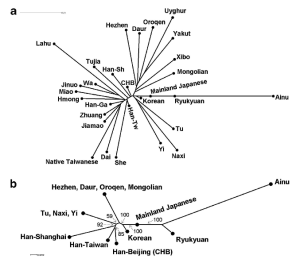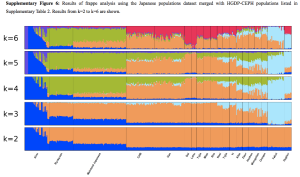I’ve been meaning to get around to this!
Here we have maps of the distribution of red hair and the distribution of blond hair. If we could overlay these maps, we’d see, especially in North Western Europe, a large overlap between the places where blond here is and red hair isn’t. It looks kind of like the blond-haired people started out somewhere around Sweeden and spread out in concentric circles from there, and as they spread, they began displacing an earlier, red-haired people who ended up surviving only on the far fringes of Britain. (The red splotch in the middle of Russia represents the Udmurt people, who could have been originally related to the ancestors of the folks on the coasts of Britain, but I suspect not.)
Luckily for me, we have historical records for this area, and we know that this is exactly what happened, what with the Germanic barbarians invading Gaul and Britain and Prussia and so on.
Anyway, so this is just an idea I’ve had kicking around in my head that when you see something like the red hair/blond hair pattern, the trait that’s in the easy to conquer, fertile, valuable areas is more recent, and the trait that’s in the fringier, more isolated places–sometimes widely separated–is the older one.
“Fringe” areas don’t have to be the edges of coasts. They can also be rainforests, mountain tops, deserts, icy tundra, etc.–just anywhere that’s far away or hard to conquer.
The Ainu
The Ainu are among the most famous Siberian peoples primarily because, once upon a time, Europeans mistook them for Caucasians, probably because the Ainu had beards and other East Asians tend not to. (I think East Asians generally can’t grow shaggy beards, but it’s hard to say because shaving one’s head is so common among men these days.)

As it turns out, merely having a beard does not, in fact, make you Caucasian; the Ainu are most closely related to other groups from north / east Asia:
Graphs from “The history of human populations in the Japanese Archipelago inferred from genome-wide SNP data with a special reference to the Ainu and the Ryukyuan populations;” Dienekes, Lindsay, and Ahnenkult (via the Wayback Machine) have excellent posts on the paper.
It’s not surprising that the Ainu aren’t actually long lost Europeans, but it is odd that they appear to be most closely–though still distantly–related to the Ryukyuans (aka Okinawans,) and mroe distantly related to their immediate neighbors, the Japanese. The Ainu hail from Hokkaido, in the far north of Japan, (though they may have previously ranged further south:
while the Okinawans hail from Japan’s southern end. Here’s another look at their respective genetics:
So we’re left with the Ainu still being quite unusual.
For that matter, their beards actually are rather unusual for the area–while the neighboring Nivkh People have beards, most of the other nearby Siberian groups, like the Yukaghirs and Oroks, (not to mention their Japanese neighbors) don’t seem particularly beardy, even though facial fur seems like it’d be useful in cold places.


To be clear, based on my past half hour’s worth of research, the Japanese (and other east-Asians) can grow beards, but their beards are generally thin and patchy due to the distribution of hair follicles. The fluffy, full beards of the Ainu appear to be rare among the Japanese and other east Asians.
I’ve yet to find a map I trust of the distribution of hairiness among humans, so we’re going with one I don’t entirely trust:
 Why are Norwegians furry, but not Siberians?
Why are Norwegians furry, but not Siberians?
Potential issues with this map: 1. Hindley and Damon gathered their estimates from the literature of their day, which means some of these numbers may be quite old; 2. Map is based on a measure of hairiness of people’s finger joints, not beards or overall body hair; 3. It looks like the numbers in the US are based on current populations rather than indigenous ones, which isn’t an issue so much as just something to be clear on; 4. the Wikipedia lists some of the numbers cited in the article, but not those for Melanesia/Indonesia/SE Asia, and the article itself is paywalled; 5. the article’s abstract notes that Solomon Islanders measured 58.8% hairy–purple–which seems in contrast to the very yellow area nearby.
At any rate, judging by the Wikipedia, lots of people rate the Ainu as “very hairy” and the Japanese as “not very hairy.”
Interestingly, the Australian Aborigines seem to have nice beards:
The article on Ainu genetics notes, “…Omoto conducted a pioneering study on the phylogenetic relationship of the Ainu population considering various degrees of admixture. When a 60% admixture with the Mainland Japanese was assumed for the modern Ainu population, the ancestral Ainu population was clustered with Sahulian (Papuan and Australian). This sort of simulations based on the real data is needed.”
Speculative… but interesting.
The Ainu belong to Y-haplogroup D-M55, a sub-clade of D-M174, which according to Wikipedia, is found “at high frequency among populations in Tibet, the Japanese archipelago, and the Andaman Islands, though curiously not in India. The Ainu of Japan are notable for possessing almost exclusively Haplogroup D-M174 chromosomes,…” (You remember our discussion of the Andaman Islanders the other day, right?)
It’d be interesting to know if the Ainu have any Denisovan admixture.
The Ainu language doesn’t seem to be related to any of the nearby languages, not even Nivkh (aside from loan words.) It’s hard to study the Ainu language, since very few people speak it anymore, but so far all of the proposed groupings sound very tentative.
The Ainu also have different teeth from their neighbors. “Sinodont” teeth are found in Japan, China, Siberia, and Native Americans. “Sundadont” teeth are found in the Ainu, Okinawans, ancient Japanese skeletons, Taiwanese aborigines, Filipinos, Indonesians, and folks from Indochina like the Thais and Laotians.
Here’s a helpful map:
 (N = Negritos; A = Australians)
(N = Negritos; A = Australians)
The word “Sundadont” refers to “Sundaland“, which is the part of Indonesia that was above water and connected to the mainland back during the last ice age. Getting to Indonesia was therefore potentially quite simple for ancient people, since they could just walk there; getting to Papua New Guinea and Australia was much more difficult, since deep water lay between them. WestHunter has an interesting post on the subject.
However, on the subject of Native American teeth, the Wikipedia notes:
“Rebecca Haydenblit of the Hominid Evolutionary Biology Research Group at Cambridge University did a study on the dentition of four pre-Columbian Mesoamerican populations and compared their data to “other Mongoloid populations”.[3] She found that “Tlatilco“, “Cuicuilco“, “Monte Albán” and “Cholula” populations followed an overall “Sundadont” dental pattern “characteristic of Southeast Asia” rather than a “Sinodont” dental pattern “characteristic of Northeast Asia”.[3]“
As we discussed previously, it looks like Melanesians may have been the first folks to reach the Americas, but were later conquered and largely wiped out by a wave of “East Asian”-like invaders.
Taken together, all of the evidence is still kind of scanty, but points to the possibility of a Melanesian-derived group that spread across south Asia, made it into Tibet and the Andaman Islands, walked into Indonesia, and then split up, with one branch heading up the coast to Taiwan, Okinawa, Japan, and perhaps across the Bering Strait and down to Brazil, while another group headed out to Australia.
Later, the ancestors of today’s east Asians moved into the area, largely displacing or wiping out the original population, except in the hardest places to reach, like Tibet, the Andaman Islands, Papua New Guinea, the Amazon Rainforest, and Hokkaido–the fringe.
Each group, of course, has gone its own way; the Ainu, for example, have mixed with the nearby Japanese and Siberian cultures, and adapted over time to their particular climate, resulting in their own, unique culture.








[…] Source: Evolutionist X […]
LikeLike
[…] Filed under Beards, Ginger hair, and recessive traits of all shapes and sizes, Evolutionist X presents the Ainu: […]
LikeLike
Historical note, the main islands of Japan were indeed once occupied by a people much like the Ainu. While they left no records, the Japanese referred to them as the “Emishi,” or “hairy ones.” The Emishi were horse archers, and had little trouble organizing powerful clans. The Japanese defeated them through strategic alliances, horse archers of their own, and eventually just breeding them out, about a thousand years ago.
LikeLike
Thanks for the note.
LikeLike
“we have historical records for this area, and we know that this is exactly what happened, what with the Germanic barbarians invading Gaul and Britain and Prussia and so on.”
You know what they say about a little knowledge….. Anyway your guesswork sounds okay if you don’t know there are different mutations that arose in different areas and some mutations result in higher percentages of people with them having red hair than others.
LikeLike
[…] have written previously about the Ainu, who are, of course, still […]
LikeLike
I remember reading that the Celts were blond much like the Germanic people though. The red hair was from before them I think.
LikeLiked by 1 person